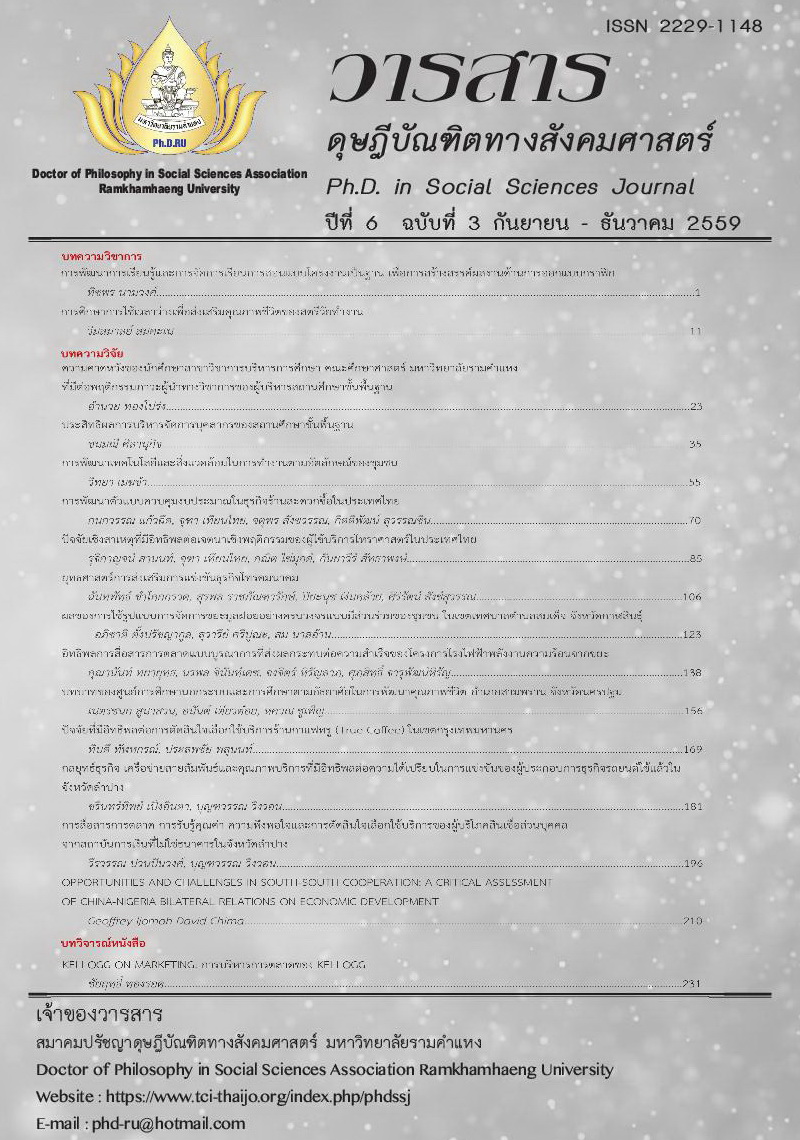ประสิทธิผลการบริหารจัดการบุคลากรของสถานศึกษาขั้นพื้นฐาน
Main Article Content
Abstract
การวิจัยครั้งนี้มีวัตถุประสงค์เพื่อศึกษาประสิทธิผลการบริหารจัดการบุคลากรของสถานศึกษาขั้นพื้นฐาน และเปรียบเทียบประสิทธิผลการบริหารจัดการบุคลากรของสถานศึกษาขั้นพื้นฐาน จำแนกตาม วุฒิการศึกษา และประสบการณ์การทำงาน
กลุ่มตัวอย่างที่ใช้ในการศึกษาครั้งนี้ ได้แก่ บุคลากรของสถานศึกษาขั้นพื้นฐาน สำนักงานเขตพื้นที่การศึกษามัธยมศึกษา เขต 2 กรุงเทพมหานคร จำนวน 52 โรงเรียน รวมบุคลากร 4,892 คน ที่กำลังปฏิบัติหน้าที่อยู่ในภาคเรียนที่ 1 ปีการศึกษา 2559 ได้มาโดยการสุ่มแบบชั้นภูมิ (stratified random sampling) กลุ่มตัวอย่างจากประชากร 52 โรงเรียน ได้กลุ่มตัวอย่างจาก 15% เท่ากับ 7.8 โรงเรียนคิดเป็น 8 โรงเรียน ได้จำนวนบุคลากร จำนวน 1,100 คน ได้กลุ่มตัวอย่าง 286 คน โดยกำหนดขนาดกลุ่มตัวอย่างที่ระดับ ความเชื่อมั่น 95% กำหนดกลุ่มตัวอย่างตามตารางสำเร็จรูปของ Krejcie and Morgan (1970, pp. 607-610) สถิติที่ใช้ ประกอบด้วย ค่าร้อยละ (Percentage) ค่าเฉลี่ยค่า () ส่วนเบี่ยงเบนมาตรฐาน (SD) และการทดสอบค่าที่ (t-test)
ผลการวิจัยพบว่า
1. ประสิทธิผลการบริหารจัดการบุคลากรของสถานศึกษาขั้นพื้นฐาน โดยภาพรวม อยู่ในระดับมาก ( = 3.87) พิจารณาเป็นรายด้านพบว่า อยู่ในระดับมาก ทุกด้าน เรียงลำดับ จากมาก ไปหาน้อย ได้แก่ ด้านความก้าวหน้าในหน้าที่การงาน (
= 3.98) ด้านการวางแผนอัตรากำลัง และด้านการสรรหา (
= 3.90) ด้านการพัฒนาบุคลากร (
= 3.89) ด้านการประเมินผลการปฏิบัติงาน (
= 3.86) และด้านการบริหารจัดการ และด้านการสร้างแรงจูงใจให้บุคลากร (
= 3.84)
2. ประสิทธิผลการบริหารจัดการบุคลากรของสถานศึกษาขั้นพื้นฐานที่มีวุฒิการศึกษาต่างกัน พิจารณาโดยภาพรวมและรายด้าน พบว่า แตกต่างกันอย่างไม่มีนัยสำคัญทางสถิติที่ระดับ .05
3. ประสิทธิผลการบริหารจัดการบุคลากรของสถานศึกษาขั้นพื้นฐาน ที่มีประสบการณ์การทำงานต่างกัน โดยภาพรวมและรายด้าน พบว่า แตกต่างกันอย่างไม่มีนัยสำคัญทางสถิติที่ระดับ .05
THE EFFECTIVENESS OF PERSONAL ADMINISTRATION IN THE OFFICE OF THE BASIC EDUCATION COMMISSION
In this research, the researcher examines (1) the study of the effectiveness of personal administration in the office of the basic education commission. The researcher also frames (2) the comparison of the effectiveness of personal administration in the office of the basic education commission in terms of the education levels and the work experiences.
The sample populations of this research are personal administration in the office of the basic education commission in the secondary educational service area office 2, Bangkok from 52 schools and 4,892 persons in the first semester in year 2016.
The sample sizes used the stratified random sampling from 52 schools. The sample from 15% equal 7.8 schools or approximately 8 schools. The population of personal administration was 1,100 persons. The sample sizes were 286 persons. The sample size used at 95 percent confidence level by the Krejcie and Morgan table sample size (1970, pp. 607-610). The statistic used percentage, mean, standard deviation and t-test.
Findings are as follows:
1. The effectiveness of personal administration in the office of the basic education commission was in the high level in general ( = 3.87). Considering of each dimension was in the high level in any dimension from high to low according to the progress in work (
= 3.98), the manpower planning and recruitment (
= 3.90), the human resource development (
= 3.89), the performance evaluation (
= 3.86), the management and the motivating personal administration (
= 3.84).
2. The effectiveness of personal administration in the office of the basic education commission in terms of education level, considering in general and in any dimension found that the difference of education level is statistically significant at .05 levels.
2. The effectiveness of personal administration in the office of the basic education commission in terms of work experience, considering in general and in any dimension found that the difference of work experience is statistically significant at .05 levels.
Article Details
Academic articles, research articles, and book reviews in the Ph.D. in Social Sciences Journal are author’s opinions, and not the publisher’s, and is not the responsibility of the Ph.D. in Social Sciences Journal Philosophy Association, Ramkhamhaeng University. (In the case that research is done on human, the researcher has to be trained in Ethics for Doing Research on Human Training and has to produce the evidence of the training).


